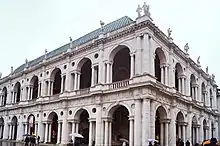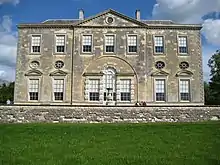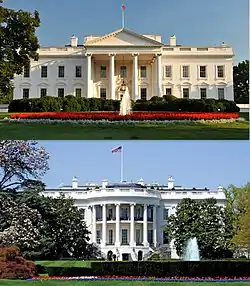帕拉第奧式建築
帕拉第奧式建筑(英語:)是一种欧洲的建筑风格。这种风格灵感来源于文艺复兴晚期威尼斯建筑师安德里亚·帕拉第奥(Andrea Palladio,1508-1580)的设计。现在所说的帕拉第奥式建筑是指对帕拉第奥最初概念的深化。帕拉第奥的作品是基于古希腊和古罗马古典神庙建筑的对称性、透视性和展现的价值来构建的。从17世纪起,帕拉第奥对这些古典建筑的诠释被统称为“帕拉第奥主义”(Palladianism)风格。这种风格一直发展到18世纪末。


在17世纪的英国,帕拉第奥主义曾一度盛行,但由于英国内战的爆发和随之而来的财政紧缩政策的实施,它的繁荣被打断了。在18世纪早期,帕拉第奥主义重新流行起来。其他欧洲国家,例如普鲁士也受到英国的直接影响。当时,弗朗西斯科·阿尔加罗蒂伯爵从柏林写信给伯灵顿勋爵,向腓特烈大帝建议在普鲁士采用伯灵顿在英国引入的建筑风格。[1]17世纪晚期,当这种风格在欧洲失宠时,却在北美的英国殖民地大受欢迎,著名建筑有南卡罗来纳州的德累顿厅、罗德岛州纽波特的红木图书馆、纽约市的莫里斯·朱梅尔大厦、马里兰州安纳波利斯的哈蒙德·哈伍德大厦和弗吉尼亚州的蒙蒂塞洛。[2]
19世纪到20世纪初,帕拉第奥式风格重新在欧洲流行,常被用于公共和市政建筑的设计。从19世纪后半叶开始,这种风格被流行于英语国家的哥特复兴风格所抵制。哥特复兴主义的追随者奥古斯塔斯·普金(Augustus Pugin)等结合帕拉第奥主义在古代庙宇中的起源,认为它相对于英国国教和英国天主教的信奉者来说太过异端。[3]当然,作为一种建筑风格,帕拉第奥式建筑继续流行并不断发展着:它的山花、对称性和比例等要素在等当今许多现代建筑的设计中都有明显体现。
帕拉第奥的建筑风格

完全由帕拉第奥设计的建筑都位于威尼斯和威尼托,其中最著名的当属维琴察的宫殿群,包括别墅和教堂,如威尼斯的红楼大教堂。帕拉第奥的建筑论文也遵循了古罗马建筑师维特鲁威和他15世纪的效仿者利昂·巴蒂斯塔·阿尔贝蒂所定义的原则:学习古罗马建筑那样基于数学比例的风格,而不是模仿文艺复兴时期的华丽装饰风格。[4]
帕拉第奥的别墅设计非常契合它所处的环境。例如坐落在山坡上的圆厅别墅,各个方向的立面被设计的具有同等价值,以便居住者从各个方向欣赏美景。而且在这种情况下,所有侧面都修建有门廊,以便居住者充分欣赏乡村风光,同时避免阳光直射。帕拉第奥有时也会用凉廊来代替门廊。这就像一个嵌入式的门廊,或者一个内部的单层房间。有时,二楼的凉廊会被放置在一层凉廊顶部上方,形成一种双凉廊。凉廊的正面有时会被山花所覆盖,从而具有重要意义。戈迪别墅的集中点是一个终止于主楼两端的凉廊。[5]
帕拉第奥经常以古罗马神庙的正面为蓝本设计别墅立面。神庙的十字形设计元素,成为了帕拉第奥作品的一个标志。帕拉第奥设计的别墅通常分为三层:最底层是一间粗琢的地下室或一楼,包含一些小房间。在这上面,主楼层通过门廊进入,门廊上有一段外部台阶,包括主要的会客室和主卧室。门廊上方是一个低夹层楼层,带有次要的卧室和起居室。别墅内每个房间的尺寸都契合某种简单的比例,如3:4和4:5,建筑内的不同房间通过这些比例联系起来。早期的建筑师一般使用这些公式来平衡建筑单个的对称立面,而帕拉第奥的设计则涉及整个方形的别墅的形态。[5]
帕拉第奥深入地思考了他的别墅的双重用途:农舍和商人的豪华周末休养地。这些对称的庙宇式房屋通常都有同样对称但较低的耳房,以容纳马、农场动物和开设农产品商店。耳房有时通过柱廊与别墅分离并连接,其设计不仅具有功能性,还可以补充和突出别墅的形态。[6]
帕拉第奥的著作《建筑四书》最早出版于1570年,包含了对他自己的建筑以及启发他创造这种风格的古罗马建筑的描述和插图[7]。帕拉第奥重新诠释了古罗马的建筑,并将其应用于各种建筑设计当中,从宏伟的别墅和公共建筑到简单的房屋和农舍。[8]
帕拉第奥窗
帕拉第奥的建筑作品中帕拉第奥式、塞里安式或威尼斯式的窗户,几乎是他早期职业生涯的标志。这一母题有两个不同的版本:一种更简单的称为威尼斯窗,另一种更精致、更具体的称为帕拉第奥窗或“帕拉第奥母题”,尽管这种区别不太明显。
威尼斯窗由三部分组成:中间是一个高的圆拱形开口,两侧有两个较小的矩形开口,后者顶部有过梁,由柱子支撑。[9]威尼斯窗灵感来源于古罗马的凯旋门,最初由多纳托·伯拉孟特(Donato Bramante)在威尼斯城外使用[10]。后来塞巴斯蒂亚诺·塞利奥(Sebastiano Serlio,1475-1554)在其建筑著作《建筑歌剧集》(Tutte l'Opre d'architettura et prospetiva)这本介绍维特鲁威和古罗马建筑的理想的书中阐释。威尼斯窗可以串联使用,但通常只在正面使用一次,例如新沃都尔城堡;或是每一端使用一次,例如伯灵顿住宅的内立面(被称为"真正的帕拉第奥式窗户")。
帕拉第奥对威尼斯窗的阐述为:在每个窗户之间放置一个巨柱式,并将支撑侧过梁的小柱子加倍,将第二根柱子放在第一根柱子的后面,而不是旁边。事实上,雅格波·桑索维诺(1537)在威尼斯的马西亚纳图书馆(Biblioteca Marciana)中介绍了这一点。帕拉第奥在维琴察的帕拉第奥巴西利卡(Basilica Palladiana)中大量使用了威尼斯窗[11]。这里的开口并不是严格意义上的窗户,因为它们围成了凉廊。在其他情况下,壁柱可能会取代柱子。约翰·萨默森爵士建议省略双柱,但术语“帕拉第奥母题”应仅限于存在较大柱式的情况。[12]
帕拉第奥广泛使用了这些元素。也许正是由于威尼斯人对这些母题的广泛使用,才使这扇窗户有了威尼斯人窗户的另一个名字:Serlian窗。无论名称或起源如何,在后来从帕拉第奥主义演变而来的建筑风格中可以看到,这种形式的窗户已经成为帕拉第奥作品中最持久的特征之一。[13]根据詹姆斯·里斯·米尔恩的说法,它在英国的首次亮相是在伦敦伯灵顿大厦的改造耳房。它的直接来源实际上是伊尼戈·琼斯对白厅宫殿的设计,而不是出自帕拉第奥本人。[14][15]
早期帕拉第奥式建筑
In 1570 Palladio published his book, I quattro libri dell'architettura, which inspired architects across Europe.
During the 17th century, many architects studying in Italy learned of Palladio's work. Foreign architects then returned home and adapted Palladio's style to suit various climates, topographies and personal tastes of their clients. Isolated forms of Palladianism throughout the world were brought about in this way. However, the Palladian style did not reach the zenith of its popularity until the 18th century, primarily in England, Wales, Scotland, Ireland and later North America.[16] In Venice itself there was an early reaction to the excesses of Baroque architecture that manifested itself as a return to Palladian principles. The earliest neo-Palladians there were the exact contemporaries, both trained up as masons, Domenico Rossi (1657–1737)[17] and Andrea Tirali (1657–1737).[18] Tommaso Temanza, their biographer, proved to be the movement's most able and learned proponent; in his hands the visual inheritance of Palladio's example became increasingly codified in correct rules and drifted towards neoclassicism.[19]
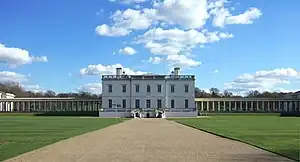
The most influential follower of Palladio anywhere, however, was the Englishman Inigo Jones, who travelled throughout Italy with the 'Collector' Earl of Arundel, annotating his copy of Palladio's treatise, in 1613–14.[20] The "Palladianism" of Jones and his contemporaries and later followers was a style largely of facades, and the mathematical formulae dictating layout were not strictly applied. A handful of great country houses in England built between 1640 and 1680, such as Wilton House, are in this Palladian style. These follow the great success of Jones' Palladian designs for the Queen's House at Greenwich and the Banqueting House at Whitehall, the uncompleted royal palace in London of King Charles I.[21]
However, the Palladian designs advocated by Inigo Jones were too closely associated with the court of Charles I to survive the turmoil of the English Civil War. Following the Stuart restoration, Jones's Palladianism was eclipsed by the Baroque designs of such architects as William Talman and Sir John Vanbrugh, Nicholas Hawksmoor, and even Jones' pupil John Webb.[22]
新帕拉第奥式建筑
English Palladian architecture
The Baroque style, popular in continental Europe, was never truly to the English taste and was considered excessively flamboyant, Catholic and 'florid'. It was quickly superseded when, in the first quarter of the 18th century, four books were published in Britain which highlighted the simplicity and purity of classical architecture. These were:
- Vitruvius Britannicus, published by Colen Campbell in 1715 (of which supplemental volumes appeared through the century),
- Palladio's I quattro libri dell'architettura, translated by Giacomo Leoni and published from 1715 onwards,
- Leon Battista Alberti's De re aedificatoria, translated by Giacomo Leoni and published 1726,
- The Designs of Inigo Jones... with Some Additional Designs, published by William Kent, 2 vols., 1727 (A further volume, Some Designs of Mr. Inigo Jones and Mr. William Kent was published in 1744 by the architect John Vardy, an associate of Kent.)
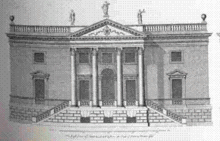
The most favoured of these among the wealthy patrons of the day was the four-volume Vitruvius Britannicus by Colen Campbell. Campbell was both an architect and a publisher. It was essentially a book of design containing architectural prints of British buildings, which had been inspired by the great architects from Vitruvius to Palladio; at first mainly those of Inigo Jones, but the later works contained drawings and plans by Campbell and other 18th-century architects. These four books greatly contributed to Palladian architecture becoming established in 18th-century Britain. Their authors became the most fashionable and sought after architects of the era. Due to his book Vitruvius Britannicus, Colen Campbell was chosen as the architect for banker Henry Hoare I's Stourhead house, a masterpiece that became the inspiration for dozens of similar houses across England.
At the forefront of the new school of design was the aristocratic "architect earl", Richard Boyle, 3rd Earl of Burlington. In 1729, he and William Kent, designed Chiswick House. This House was a reinterpretation of Palladio's Villa Capra, but purified of 16th century elements and ornament. This severe lack of ornamentation was to be a feature of the English Palladianism. In 1734 William Kent and Lord Burlington designed one of England's finest examples of Palladian architecture with Holkham Hall in Norfolk. The main block of this house followed Palladio's dictates quite closely, but Palladio's low, often detached, wings of farm buildings were elevated in significance. Kent attached them to the design, banished the farm animals, and elevated the wings to almost the same importance as the house itself. These wings were often adorned with porticos and pediments, often resembling, as at the much later Kedleston Hall, small country houses in their own right. It was the development of the flanking wings that was to cause English Palladianism to evolve from being a pastiche of Palladio's original work.

Architectural styles evolve and change to suit the requirements of each individual client. When in 1746 the Duke of Bedford decided to rebuild Woburn Abbey, he chose the Palladian style for the design, as this was now the most fashionable of the era. He selected architect Henry Flitcroft, a protégé of Burlington. Flitcroft's designs, while Palladian in nature, would not be recognised by Palladio himself. The central block is small, only three bays, the temple-like portico is merely suggested, and it is closed. Two great flanking wings containing a vast suite of state rooms replace the walls or colonnades which should have connected to the farm buildings; the farm buildings terminating the structure are elevated in height to match the central block and given Palladian windows, to ensure they are seen as of Palladian design. This development of the style was to be repeated in countless houses and town halls in Britain over one hundred years. Falling from favour during the Victorian era, it was revived by Sir Aston Webb for his refacing of Buckingham Palace in 1913. Often the terminating blocks would have blind porticos and pilasters themselves, competing for attention with, or complementing the central block. This was all very far removed from the designs of Palladio two hundred years earlier.
English Palladian houses were now no longer the small but exquisite weekend retreats from which their Italian counterparts were conceived. They were no longer villas but "power houses" in Sir John Summerson's term, the symbolic centres of power of the Whig "squirearchy" that ruled Britain. As the Palladian style swept Britain, all thoughts of mathematical proportion were swept away. Rather than square houses with supporting wings, these buildings had the length of the façade as their major consideration: long houses often only one room deep were deliberately deceitful in giving a false impression of size.
Irish Palladianism
During the Palladian revival period in Ireland, even quite modest mansions were cast in a neo-Palladian mould. Palladian architecture in Ireland subtly differs from that in England. While adhering as in other countries to the basic ideals of Palladio, it is often truer to them – perhaps because it was often designed by architects who had come directly from mainland Europe, and therefore were not influenced by the evolution that Palladianism was undergoing in Britain. Whatever the reason, Palladianism still had to be adapted for the wetter, colder weather.
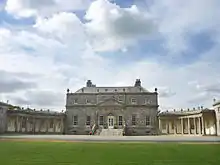
One of the most pioneering Irish architects was Sir Edward Lovett Pearce (1699–1733), who became one of the leading advocates of Palladianism in Ireland. A cousin of Sir John Vanbrugh, he was originally one of his pupils, but rejecting the Baroque style, he spent three years studying architecture in France and Italy, before returning home to Ireland. His most important Palladian work is the former Irish Houses of Parliament in Dublin. He was a prolific architect who also designed the south façade of Drumcondra House in 1725 and Summerhill House in 1731, which was completed after Pearce's death by Richard Cassels.[24]
Pearce oversaw the building of Castletown House, near Dublin, designed by the Italian architect Alessandro Galilei (1691–1737). It is perhaps the only Palladian house in Ireland to have been built with Palladio's mathematical ratios, and one of the three Irish mansions which claim to have inspired the design of the White House in Washington.
Other examples include Russborough, designed by Cassels, who also designed the Palladian Rotunda Hospital in Dublin and Florence Court in County Fermanagh. Irish Palladian country houses often feature robust Rococo plasterwork, frequently executed by the Lafranchini brothers, an Irish specialty, which is far more flamboyant than the interiors of their contemporaries in England. So much of Dublin was built in the 18th century that it set a Georgian stamp on the city; however arising out of bad planning and poverty, until recently Dublin was one of the few cities where fine 18th-century housing could be seen in ruinous condition. Elsewhere in Ireland after 1922, the lead was removed from the roofs of unoccupied Palladian houses for its value as scrap, with the houses often abandoned owing to excessive roof-rate based taxes. Some roofless Palladian houses can still be found in the depopulated Irish countryside.
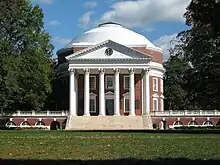
North American Palladianism
Palladio's influence in North America[25] is evident almost from the beginning of architect-designed building there, though the Irish philosopher George Berkeley may have been America's pioneering Palladian. Acquiring a large farmhouse in Middletown, near Newport in the late 1720s, Berkeley dubbed it "Whitehall" and improved it with a Palladian doorcase derived from William Kent's Designs of Inigo Jones (1727), which he may have brought with him from London.[26] Palladio's work was included in the library of a thousand volumes he amassed for the purpose and sent to Yale College.[27] In 1749, Peter Harrison adopted the design of his Redwood Library in Newport, Rhode Island, more directly from Palladio's I quattro libri dell'architettura, while his Brick Market, also in Newport, of a decade later is also Palladian in conception.[28]
The Hammond-Harwood House in Annapolis, Maryland (illustration) is an example of Palladian architecture in the United States. It is the only existing work of colonial academic architecture that was principally designed from a plate in Palladio's Quattro libri. The house was designed by the architect William Buckland in 1773–74 for wealthy farmer Matthias Hammond of Anne Arundel County, Maryland. It was modeled on the design of the Villa Pisani in Montagnana, Italy in Book II, Chapter XIV of I quattro libri dell’achitettura.
The politician and architect Thomas Jefferson (1743–1826) once referred to Palladio's Quattro libri as his bible. Jefferson acquired an intense appreciation of Palladio's architectural concepts, and his designs for his own beloved Monticello,[29] the James Barbour Barboursville estate, Virginia State Capitol, and the University of Virginia were based on drawings from Palladio's book.[30] Realizing the powerful political significance pertaining to ancient Roman buildings, Jefferson designed his civic buildings in the Palladian style. Monticello (remodelled between 1796 and 1808) is quite clearly based on Palladio's Villa Capra, however, with modifications, in a style which is described in America today as Colonial Georgian. Jefferson's Pantheon or Rotunda at the University of Virginia is undeniably Palladian in concept and style.[31]
.jpg.webp)
In Virginia and Carolina, the Palladian manner is epitomised in numerous Tidewater plantation houses, such as Stratford Hall or Westover Plantation, or Drayton Hall near Charleston. These examples are all classic American colonial examples of a Palladian taste that was transmitted through engravings, for the benefit of masons—and patrons, too—who had no first-hand experience of European building practice. A feature of American Palladianism was the re-emergence of the great portico which, again, as in Italy, fulfilled the need of protection from the sun; the portico in various forms and size became a dominant feature of American colonial architecture. In the north European countries the portico had become a mere symbol, often closed, or merely hinted at in the design by pilasters, and sometimes in very late examples of English Palladianism adapted to become a porte-cochère; in America, the Palladian portico regained its full glory.
One house which clearly shows this Palladian-Gibbs influence is Mount Airy, in Richmond County, Virginia, built in 1758–62.[32]
At Westover the north and south entrances, made of imported Portland stone, were patterned after a plate in William Salmon's Palladio Londinensis (1734).[33]
The distinctive feature of Drayton Hall, its two-storey portico, was derived directly from Palladio.[34]
The neoclassical presidential mansion, the White House in Washington, was inspired by Irish Palladianism. Both Castle Coole and Richard Cassel's Leinster House in Dublin claim to have inspired the architect James Hoban, who designed the executive mansion, built between 1792 and 1800. Hoban, born in Callan, County Kilkenny, in 1762, studied architecture in Dublin, where Leinster House (built c. 1747) was one of the finest buildings at the time. The White House is more neoclassical than Palladian, particularly the South façade, which closely resembles James Wyatt's 1790 design for Castle Coole, also in Ireland. Castle Coole is, in the words of the architectural commentator Gervase Jackson-Stops, "A culmination of the Palladian traditions, yet strictly neoclassical in its chaste ornament and noble austerity."[35]
One of the adaptations made to Palladianism in America was that the piano nobile, now tended to be placed on the ground floor rather than above a service floor, as was the tradition in Europe. This service floor, if it existed at all, was now a discreet semi-basement. This negated the need for an ornate external staircase leading to the main entrance as in the more original Palladian designs. This would also be a feature of the neoclassical style that followed Palladianism.
.jpg.webp)
The only two houses in the United States from the English colonial period (1607–1776) that can be definitively attributed to designs from I quattro libri dell'architettura are architect William Buckland's Hammond-Harwood House (1774) in Annapolis, Maryland and Thomas Jefferson's first Monticello. The design source for the Hammond-Harwood House is Villa Pisani, Montagnana (Book II, Chapter XIV), and for the first Monticello (1770) the design source is Villa Cornaro at Piombino Dese (Book II, Chapter XIV). Thomas Jefferson later covered this façade with additions so that the Hammond-Harwood House remains the only pure and pristine example of direct modeling in America today.[36]
Because of its later development, Palladian architecture in Canada is rare. One notable example is the Nova Scotia Legislature building, completed in 1819. Another example is Government House in St. John's, Newfoundland.
The Center for Palladian Studies in America, Inc., a non-profit membership organization, was founded in 1979 to research and promote understanding of Palladio's influence in the United States.[37]
遗产

B到 1770 年代的英國,像羅伯特·亞當 (Robert Adam) 和威廉·錢伯斯爵士 (Sir William Chambers) 这样的建築師的需求量很大,但他們現在借鑑了包括古希臘在內的各種古典資源,以至於他們的建築形式最終被定義為新古典主義而非帕拉第奧式。在歐洲,帕拉第奧的複興在 18 世紀末結束。在北美,帕拉第奧主義徘徊的時間更長。 Thomas Jefferson 的平面圖和立面圖很大程度上歸功於 Palladio 的 Quattro libri。今天,“帕拉第奧”一詞經常被誤用,並傾向於描述具有任何古典自負的建築。然而,在 20 世紀初的殖民複興主義者中,帕拉第奧式的思想出現了復興,即使在現代主義時期,這種壓力也從未間斷
In the mid-20th century, the originality of the approach of the architectural historian Colin Rowe had the effect of re-situating the assessment of modern architecture within history and acknowledged the Palladian architecture as an active influence. In the later 20th century, when Rowe's influence had spread worldwide, this approach had become a key element in the process of architectural and urban design. If "the presence of the past" was evident in the work of many architects in the late 20th century, from James Stirling to Aldo Rossi, Robert Venturi, Oswald Matthias Ungers, Peter Eisenman, Michael Graves and others, this was largely due to the influence of Rowe. Colin Rowe's unorthodox and non-chronological view of history then made it possible for him to develop theoretical formulations such as his famous essay "The Mathematics of the Ideal Villa" (1947) in which he theorised that there were compositional "rules" in Palladio's villas that could be demonstrated to correspond to similar "rules" in Le Corbusier's villas at Poissy and Garches.[38] This approach enabled Rowe to elaborate an astonishingly fresh and provocative trans-historical assessment of both Palladio and Le Corbusier, in which the architecture of both was assessed not in chronological time, but side by side in the present moment.[38]
另见
- 新古典主义建筑
- Kerelaw House
- Poplar Forest
- Stoke Park Pavilions
- 贾科莫·奎朗(Giacomo Quarenghi)
- 布伦塔河
参考文献
- James Lees-Milne, The Earls of Creation 1962:120.
- The Center for Palladian Studies in America, Inc., "Palladio and English-American Palladianism." 的存檔,存档日期2009-10-23.
- Frampton, p. 36
- Copplestone, p.250
- Copplestone, p.251
- Copplestone, pp.251–252
- webmaster@vam.ac.uk, Victoria and Albert Museum, Digital Media. . www.vam.ac.uk. [2017-07-07]. (原始内容存档于2019-07-17) (英国英语).
- Kerley, Paul. . BBC News. 2015-09-10 [2017-07-07]. (原始内容存档于2019-03-06) (英国英语).
- Summerson, 134
- Ackerman, Jaaes S. (1994). Palladio (series "Architect and Society")
- Summerson, 129-130
- Summerson, 130
- Andrea Palladio, Caroline Constant. The Palladio Guide. Princeton Architectural Press, 1993. p. 42.
- "The earliest example of the revived Venetian window in England", Lees-Milne, The Earls of Creation, 1962:100.
- James Lees-Milne 1962:133f.
- Copplestone, p.252
- Rossi built the new façade for the rebuilt Sant'Eustachio, known in Venice as San Stae, 1709, which was among the most sober in a competition that was commemorated with engravings of the submitted designs, and he rebuilt Ca' Corner della Regina, 1724–27 (Deborah Howard and Sarah Quill, The Architectural history of Venice, 2002: 238f).
- His façade of San Vidal is a faithful restatement of Palladio's San Francesco della Vigna and his masterwork is Tolentini, Venice, 1706–14 (Howard and Quill 2002)
- Robert Tavernor, Palladio and Palladianism Thames & Hudson, 1991:112.
- Hanno-Walter Kruft. A History of Architectural Theory: From Vitruvius to the Present. Princeton Architectural Press, 1994 and Edward Chaney, Inigo Jones's 'Roman Sketchbook, 2006).
- Copplestone, p.280
- Copplestone, p.281
- . Irish Architectural Archive. 2010 [23 September 2018]. (原始内容存档于2018-09-23).
- Sheridan, Pat. . Dublin Historical Record. 2014, 67 (2): 19–25. JSTOR 24615990.
- A brief survey is Robert Tavernor, "Anglo-Palladianism and the birth of a new nation" in Palladio and Palladianism, 1991:181–209; Walter M. Whitehill, Palladio in America, 1978 is still the standard work.
- Edwin Gaustad, George Berkeley in America (Yale University Press, 1979): "Berkeley's one architectural achievement in the New World" (p. 70).
- Gaustad, p. 86.
- The Center for Palladian Studies in America, Inc., "Building America." 的存檔,存档日期2009-12-23.
- Fiske Kimball, Thomas Jefferson, Architect, 1916.
- Frederick Nichols, Thomas Jefferson's Architectural Drawings, 1984.
- Joseph C. Farber, Henry Hope Reed. . Dover Publications. 1980: 107. ISBN 0-486-23922-5.
- Roth, Leland M., A Concise History of American Architecture, Harper & Row, Publishers, NY, 1980
- Severens, Kenneth, Southern Architecture: 350 Years of Distinctive American Buildings, E.P. Dutton, NY 1981 p 37; specifically, both doors seem to have been derived from plates XXV and XXVI of Palladio Londinensis, a builders guide first published in London in 1734, the very year when the doorways may have been installed. (Morrison, High, American's First Architecture: From the First Colonial Settlements to the National Period. Oxford University Press, NY 1952 p. 340).
- Severens, Kenneth, Southern Architecture: 350 Years of Distinctive American Buildings, E.P. Dutton, NY 1981 p 38
- Jackson-Stops p. 106
- . Hammond-Harwood House Association. [2 December 2011]. (原始内容存档于2014-02-02).
- . Palladian Studies. [8 August 2020]. (原始内容存档于2022-01-01).
- The Mathematics of the Ideal Villa and Other Essays, MIT Press, Main essay reprinted in collected works volume, (1976).
参考文献
- Ackerman, Jaaes S. (1994). Palladio (series "Architect and Society").
- Chaney, Edward (2006). "George Berkeley's Grand Tours: The Immaterialist as Connoisseur of Art and Architecture", in The Evolution of the Grand Tour: Anglo-Italian Cultural Relations Since the Renaissance (2nd ed.). Routledge. ISBN 0-7146-4474-9.
- Copplestone, Trewin (1963). World Architecture. Hamlyn.
- Dal Lago, Adalbert (1966). Ville Antiche. Milan: Fratelli Fabbri.
- Frampton, Kenneth. (2001). Studies in Tectonic Culture. MIT Press. ISBN 0-262-56149-2.
- Halliday, E" E. (1967). Cultural History of England. London: Thames and Hudson.
- Jackson-Stops, Gervase (1990). The Country House in Perspective. Pavilion Books Ltd.
- Kostof, Spiro. A History of Architecture. New York: Oxford University Press.
- Lewis, Hilary, and John O'Connor (1994). Philip Johnson: The architect in His Own Words. New York: Rizzoli International Publications.
- Marten Paolo (1993). Palladio. Koln: Benedikt Taschen Verlag GmbH. (Photos of Palladio's surviving buildings)
- Reed, Henry Hope, and Joseph C. Farber (1980). Palladio's Architecture and Its Influence. New York: Dover Publications.
- Ruhl, Carsten (2011). Palladianism: From the Italian Villa to International Architecture (页面存档备份,存于), European History Online. Mainz: Institute of European History. Retrieved: May 23, 2011.
- Summerson, John, The Classical Language of Architecture, 1980 edition, Thames and Hudson World of Art series, ISBN 0500201773
- Tavernor, Robert (1979). Palladio and Palladianism (series "World of Art").
- Watkin, David (1979). English Architecture. London: Thames and Hudson.
- Wittkower, Rudolf. Architectural Principles in the Age of Humanism.
外部链接
| 维基共享资源上的相关多媒体资源:帕拉第奧式建築 |
| 英文维基文库中的《1911年版大英百科全書》條目:Palladian |
- Chiswick House (页面存档备份,存于)
- Holkham Hall (页面存档备份,存于)
- (英語和義大利語) International centre for the study of the architecture of Andrea Palladio (CISA)
- Palladian Architecture in England (页面存档备份,存于)
- The Center for Palladian Studies in America, Inc. (页面存档备份,存于)
- Palladio's Villas (页面存档备份,存于)
- Thomas Jefferson's architecture (页面存档备份,存于)
- Woburn Abbey (页面存档备份,存于)
- Wallington Hall – National Trust
- The Palladian Way long distance walk (页面存档备份,存于)
- . British Galleries. Victoria and Albert Museum. [2007-07-17]. (原始内容存档于2012-03-07).
